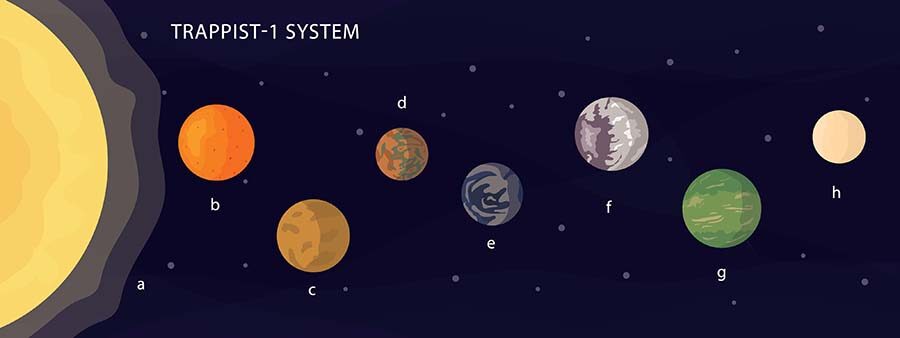11 Exoplanet Facts for Fun Learning
Whilst the name sounds quite mysterious and complex, an exoplanet is simply a planet that exists outside of our solar system. There are many of them out there, leading us to wonder whether there’s another one that might be similar to Earth, and having the possibility to sustain life.
And the truth is that there are probably more confirmed extrasolar planets than you may think, though they’re not too much different from our planets. So, let’s look at some interesting facts about exoplanets.
- Although we’ve known about the planets in our solar system for centuries, we didn’t discovered the first exoplanet until 1995. Its name is Dimidium, or 51 Pegasi b.
- We have studied about exoplanets for decades now. However, it wasn’t until 2013 that we was actually able to identify the color of one of these exoplanets. This exoplanet, named HD 189733b, is visible in the constellation Vulpecula. It is a dark blue color.
- We think that there are as many as 10 billion exoplanets out there inside of our galaxy, but outside of our solar system. Who knows how many there are if we considered ones in other galaxies!
- To date, there have been more than 4,000 exoplanets identified by the Kepler space telescope and NASA’s TEES satellite.
- It’s estimated than around 20% of the stars out there like our Sun have a planet like Earth orbiting it.
- We even know that these exoplanets have an atmosphere surrounding them like our planets.
- Of these exoplanets, many of them are thought to have exomoons orbiting them. In fact, we’re discovering more exomoons each year.
- The largest exoplanet that we know of is orbiting a star called Muscae, or HD 100546. We refer to it as HD 100546b.
- The closest exoplanet to our galaxy is called Proxima Centauri b, which can be found in the constellation Centaurus.
- One of the best examples of a group of exoplanets orbiting a planet is the Trappist 1 system.
- Though the term exoplanet is probably the most common nowadays, you’ll often hear people refer to them as extrasolar planets too. An extrasolar planet is just the same thing; a planet that’s outside of our solar system.
Trappist 1 is a star located in the constellation Aquarius. It is a good example of an system that has exoplanets, which we refer to by letter depending on their distance. It is around 40 light years from our Sun. Trappist 1 is a cool star, with an average temperature of 2,000°c.

- B – This exoplanet is similar to our planet Venus, with a rocky core and a similar mass to Earth.
- C – This is another exoplanet like Venus, with a thick atmosphere surrounding it.
- D – This exoplanet is much smaller than the previous ones, with a mass that is only around 30% of that of the Earth.
- E – This planet is very similar to Earth in mass, radius, temperature and gravity.
- F – Although it is a rocky planet, this one is surrounded by steam and gas of a high temperature.
- G – The second furthest away, G is likely to hold a lot of water due to it’s density.
- H – This exoplanet has a low density, meaning it is also likely to hold water.
When we’re identifying exoplanets, we generally put them into different categories based on the planets in our solar system. We can identify them by size, in which case we use thse names; rocky planets; super-Earths; mini-Neptunes; ice giants; and gas giants. We also refer to exoplanets by their distance from the star, with names Hot Jupiter and Hot Neptune for those closer, and Cold Jupiter and Cold Neptune for those further away.
Sometimes, you might hear astronomers refer to an area as the Goldilocks zone. Although the name might appear quite strange, it’s actually quite simple. This is the area around a star (like our Sun) which isn’t too hot or too cold (like Goldilocks porridge!), making it just right for water to exist on a planet.
Although we aren’t sure, we think that exoplanets likely have the same composition as the planets in our solar system. This makes them composed of materials like iron, oxygen, magnesium, and silicon, as well as carbon.
If you look up in the night sky, it can be difficult to tell stars and exoplanets apart. When we’re looking for exoplanets, we generally try and look for something called a ‘wobbly’ star. This is because the exoplanet will make the star look like it’s wobbling, which is how you can tell an exoplanet is orbiting it.
Although you might have heard Pluto is an exoplanet, this isn’t the case. Exoplanets have to be outside of our solar system, which isn’t the case for Pluto. Pluto is classified as a dwarf planet, not an exoplanet.
To sum it up, an exoplanet is just the name we give to any planet that is outside of our solar system. There are many Earth sized planets out there that may be similar to our own terrestrial planets, however we still would have no idea whether they’d be habitable or not – there’s also gas giant exoplanets to consider too.
Though we still don’t know everything about them, we know much more than we did 30 years ago (which was literally nothing!). Hopefully you’ve found these exoplanet facts useful).